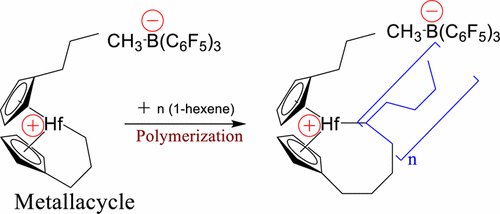当前位置:
X-MOL 学术
›
Organometallics
›
论文详情
Our official English website, www.x-mol.net, welcomes your
feedback! (Note: you will need to create a separate account there.)
Mass Spectrometric Mechanistic Investigation of Ligand Modification in Hafnocene-Catalyzed Olefin Polymerization
Organometallics ( IF 2.5 ) Pub Date : 2017-09-07 00:00:00 , DOI: 10.1021/acs.organomet.7b00293 Anthony P. Gies 1 , Roger L. Kuhlman 2 , Cristiano Zuccaccia 3 , Alceo Macchioni 3 , Richard J. Keaton 1
Organometallics ( IF 2.5 ) Pub Date : 2017-09-07 00:00:00 , DOI: 10.1021/acs.organomet.7b00293 Anthony P. Gies 1 , Roger L. Kuhlman 2 , Cristiano Zuccaccia 3 , Alceo Macchioni 3 , Richard J. Keaton 1
Affiliation

|
We recently reported evidence that a cyclometalated intermediate can facilitate the polymerization of 1-hexene to append polymer chains to the termini of propyl groups of the Me2Hf(Cpn-Propyl)2 catalyst precursor. Herein we provide further mechanistic details on the activation of Me2Hf(Cpn-Propyl)2 by B(C6F5)3 and the polymerization of 1-hexene mainly by applying a battery of mass spectrometry-based techniques. First, a combination of MALDI and CID fragmentation is used to characterize the high molecular mass region (up to 6 kDa) of the isolated poly(1-hexene) material with attached metallocene. The CID fragmentation patterns are explained by relatively low-energy ligand losses and higher energy hydrocarbon chain degradation via C–C bond cleavage and 1,3-hydrogen shift reactions. Further mechanistic insights are gained by investigating 1-hexene polymerization reaction employing a properly 13C-labeled catalyst activated by B(C6F5)3. Mass spectrometry analyses, along with supporting NMR experiments, indicate that polymer chain growth from the propylcyclopentadienyl ligand proceeds via a series of 2,1-insertion ring expansions of the hafnium metallacycle. In contrast, free poly(1-hexene) chains are generated by conventional 1,2-insertions. In addition, six boron-containing species were identified from negative ion mode ESI-QqTOF: [B(C6F5)3]−•, [H–B(C6F5)3]−, [CH3–B(C6F5)3]−, [HO–B(C6F5)3]−, [C6H13–B(C6F5)3]−, and [B(C6F5)4]−.
中文翻译:

f茂金属催化的烯烃聚合中配体修饰的质谱机理研究
我们最近报道的证据表明,环金属化的中间体可以促进1-己烯的聚合,以将聚合物链附加到Me 2 Hf(Cp n -Propyl)2催化剂前体的丙基末端。本文中,我们提供了有关B(C 6 F 5)3活化Me 2 Hf(Cp n -Propyl)2的更多机理的详细信息。1-己烯的聚合主要通过应用基于质谱技术的电池进行。首先,结合使用MALDI和CID断裂来表征分离的带有茂金属的聚(1-己烯)材料的高分子量区域(最高6 kDa)。CID片段化的模式可以通过较低的能量配体损失和通过CC键断裂和1,3-氢转移反应引起的较高能量的烃链降解来解释。通过研究使用已被B(C 6 F 5)3活化的13 C标记的适当催化剂的1-己烯聚合反应,可以获得更多的机理信息。。质谱分析以及支持的NMR实验表明,丙基环戊二烯基配体的聚合物链增长是通过metal金属环的一系列2,1-插入环扩展进行的。相反,通过常规的1,2-插入可产生自由的聚(1-己烯)链。此外,从负离子模式ESI-QqTOF中鉴定出六种含硼物质:[B(C 6 F 5)3 ] -•,[H–B(C 6 F 5)3 ] -,[CH 3 -B (C 6 F 5)3 ] -,[HO–B(C 6 F 5)3 ] -,[C 6 H 13 -B(C 6 F 5)3 ] -和[B(C 6 F 5)4 ] -。
更新日期:2017-09-07
中文翻译:

f茂金属催化的烯烃聚合中配体修饰的质谱机理研究
我们最近报道的证据表明,环金属化的中间体可以促进1-己烯的聚合,以将聚合物链附加到Me 2 Hf(Cp n -Propyl)2催化剂前体的丙基末端。本文中,我们提供了有关B(C 6 F 5)3活化Me 2 Hf(Cp n -Propyl)2的更多机理的详细信息。1-己烯的聚合主要通过应用基于质谱技术的电池进行。首先,结合使用MALDI和CID断裂来表征分离的带有茂金属的聚(1-己烯)材料的高分子量区域(最高6 kDa)。CID片段化的模式可以通过较低的能量配体损失和通过CC键断裂和1,3-氢转移反应引起的较高能量的烃链降解来解释。通过研究使用已被B(C 6 F 5)3活化的13 C标记的适当催化剂的1-己烯聚合反应,可以获得更多的机理信息。。质谱分析以及支持的NMR实验表明,丙基环戊二烯基配体的聚合物链增长是通过metal金属环的一系列2,1-插入环扩展进行的。相反,通过常规的1,2-插入可产生自由的聚(1-己烯)链。此外,从负离子模式ESI-QqTOF中鉴定出六种含硼物质:[B(C 6 F 5)3 ] -•,[H–B(C 6 F 5)3 ] -,[CH 3 -B (C 6 F 5)3 ] -,[HO–B(C 6 F 5)3 ] -,[C 6 H 13 -B(C 6 F 5)3 ] -和[B(C 6 F 5)4 ] -。











































 京公网安备 11010802027423号
京公网安备 11010802027423号